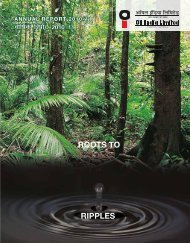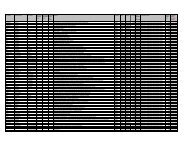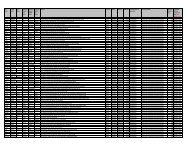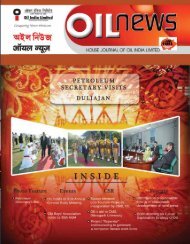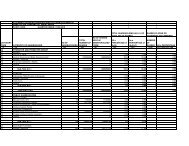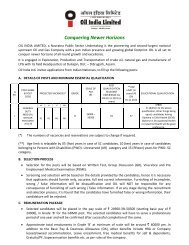2005 - Oil India Limited
2005 - Oil India Limited
2005 - Oil India Limited
Create successful ePaper yourself
Turn your PDF publications into a flip-book with our unique Google optimized e-Paper software.
OIL beyond territorial barriers<br />
Brand - a historical perspective<br />
Branding has a long history. The word 'brand' is derived<br />
from the word brandr, a word used by early Norse<br />
tribesman meaning 'to burn' as in branding livestock to<br />
declare ownership. Although popularly the differentiating<br />
of cattle by their owners in the wild west is considered to<br />
be the more recent roots of modern day complex branding<br />
process, brands have been used as marks of identification<br />
at some time in all countries and civilizations. The<br />
branding scene below is shown on Egyptian Tomb walls<br />
dating back to 2,000 B.C.<br />
BRANDS WERE APPLIED TO HUMANS AS RECENT AS<br />
1822.<br />
For over 4,000 years, brands have been used for<br />
identification on both livestock and humans. Fugitives,<br />
galley slaves, gypsies, vagabonds, brawlers, and the<br />
clergy have been marked with "symbols of shame" brands<br />
down through history. The science of brand reading<br />
almost requires a language of its own. Amazingly, every<br />
numeral and letter of the alphabet can be made with an<br />
iron shaped in a configuration.<br />
Until modern times, to prevent theft, livestock being<br />
driven across country were required to be "road branded".<br />
The brands were painted on with pine tar or paint in early<br />
history. Later, when the vast trail herds of cattle were<br />
driven north to market, hot iron brands were used.<br />
Rustlers using "running irons" were ingenious in changing<br />
brands. The most famous brand change involved making<br />
the X I T brand into a Star with a cross inside.<br />
“Over the years brands evolved from being an<br />
identifier, than a discriminator and finally a repository<br />
of shared meanings & beliefs.”<br />
Corporate Branding<br />
Every successful brand has managed to communicate its<br />
company's core beliefs and attitudes what the company<br />
stands for to its target customers. Over the last hundred<br />
years there has been a proliferation of products due to<br />
mass production and distribution. As technologies<br />
developed it became increasingly difficult to<br />
differentiate in a given product category. Without having<br />
strong brands, consumers find it difficult to make a<br />
choice between a large number of products and services.<br />
In such situations, strong brands can differentiate<br />
between similar products and consumers use brands as a<br />
mechanism to make purchase decisions.<br />
Brands allow you to clearly define and communicate<br />
what you stand for, whether you're the "lowest-cost<br />
provider," the "most innovative," the "best total solution,"<br />
the "preferred choice" and so on.<br />
<strong>India</strong>n brands like Colgate and Godrej have touched the<br />
zenith of brand value, which is reflected in the fact they<br />
have become generic names (people use these brand<br />
names loosely for all other toothpaste/steel cabinets<br />
brands).<br />
There is evidence available worldwide that the<br />
performance of Companies is directly linked with the<br />
strength of the brand name. A study conducted by<br />
Mckinsey in 1999 across 130 countries worldwide<br />
demonstrated that an average the total return to the<br />
shareholder was five percentage points higher than<br />
companies which had weak brands.<br />
“Target Groups, Communication Content and Methods<br />
& Modes are the main constituents of Corporate<br />
Branding.”<br />
Brand Value<br />
For the fourth consecutive year, Business Week has<br />
teamed up with Interbrand, a leading brand consultancy,<br />
to publish a ranking of The 100 Best Global Brands by<br />
dollar value. This year's rankings rewarded companies<br />
29





